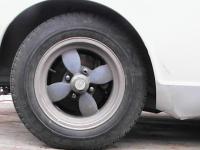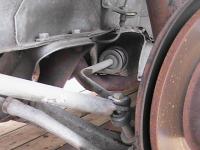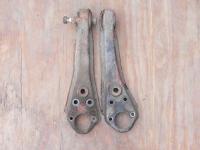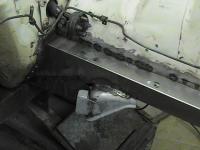Everything posted by Seppi72
-
L28+(maxima)47 build
So, madcaw, have you been able to cc the machined head yet?
-
Triple Mikuni thread
I'm really liking this thread. I have a set of Mikuni 44s destined for my L28 stroker and am going to commit your info to memory when I get the time to put them on. I also have a set of Weber 40s that I bought as a back-up or to go on my "regular" Rebello L28 at some other point in time. Either way, it's a fascinating (to me) discussion among you guys.
-
Plastic welders
I'm not familar with the '78 model. All my Zs are '72s and they do not have this type of A-pillar finisher parts. However... I am familar with automotive plastics and if these are rigid parts they are undoubtedly made from ABS plastic. For many decades, most interior trim parts have been made from ABS of one sort or another. There are, literally, hundreds of variations in the formulations that have been used worldwide. You can find a pretty good solvent system for ABS in the plumbing department of any hardware or home inprovement store. Get the stuff for cleaning the surfaces prior to gluing parts together. That will mildly attack the surface, removing grime without causing dimensional distortions like swelling and make it more amenable to further bonding. If, in fact, you have the screw bosses, you might consider then using an ABS glue mixture (from the same plumbing department) to reattach them to the main part. After drying for a while, say, 12 hours, you could then bolster the joint by light sanding and coating with the epoxy.
-
Gauge overlays
Lon: I can't and won't argue with your credentials or advice. I'm just happy there's someone here who knows precision mechanicals. It is strange, though. The speedo pointer went back on its shaft just fine and is nice and snug. However, the tach pointer is way loose on its shaft and I really don't see any reason for that unless something really tiny pulled off with the pointer during removal and got lost on my workbench. The tach's "movement" seems to be A-OK, however. So, what would you recommend I do to "snug up" the fit of the pointer on its shaft?
-
Gauge overlays
Absolutely. Depending on how "tight" they feel after being reinstalled I'll probably use a toothpick to put a dap of either cyanoacrylate (super glue) or epoxy at the joint. BTW, the pointers look really sharp now that I've spray painted them with fluorescent orange. I'm anxious to get the gauges reassembled and see how they look but I've got to paint the insides of the "canisters" with bright white to reflect whatever color LED ends up being in them.
-
Gauge overlays
Those pointers took a LOT of force to remove!! I actually had to use a paint can lid removing tool to generate enough force to pop the speedo pointer. BTW, Dave, thanks for the tip on letting the speedo needle hang before removal.:classic: There was a little white dot on the face of the OEM gauge where it rested and I marked that on the backside edge. Now, I just have to spray paint the pointers DayGlo orange (or black) before I reinstall them. White pointers don't show up too well on white gauge faces.
-
Gauge overlays
I plan to put the white-face, self-adhesive, vinyl overlays on my various gauges and have a relatively simple question: How do you remove the tach and speedo needles without doing any damage? At first, I thought they would just pull straight off, but after applying what I feel is enough force, they remain on the spindle.
-
Frame rail interchangability
I need to do some repair on a 240Z front frame rail (its bent inwards towards the engine) from about the strut tower to just behind the T/C mounting bracket. I can get donor parts from a 280Z 2+2 but I'm uncertain whether these would be interchangable. I don't have my S30 parts CD with me today so if anyone knows the answer, please post it. I suppose that I could always fabricate what I need, but using good donor parts seems the better way to go.
-
Rear Toe Adjustment Cost
I'm planning to pre-empt any such problems on my rebuilt original-owner '72 by going with Techno Toy Tuning's adjustable control arms (front and rear) as well as its adjustable T/C rods (http://www.technotoytuning.com/productlist.php?vehicleid=11). I have the latter on my other '72 - the one I "bent" a year ago during an off-road excursion - and I am very happy with the parts. The really nice thing about the TTT rear arms is that they allow adjustment of camber, caster and toe on the rear wheels using turnbuckles and (for caster) shims. I also think that the front arms will allow for even more camber range than using the typical slotted shock tower insert - and be more stable to boot. And, yeah, perhaps the $1000 this will cost is a bit much for some people's taste, but it is at least money spent making the car corner better - something an extra $1000 in the paint job (flames and a hood mural, anyone?) can't do for me.
-
Motorsports MSA Fiberglass bumper
My body guy was lining up the other set of MSA fiberglass bumpers to determine where the "cut ins" needed to be on the rear quarter panels and saw that those brackets didn't line up very well either. But, he took a different route to fixing the issue. :bulb:He used a cut-off wheel on the resin holding the bracket edges to the inner bumper wall and they came off just fine. He then ground the residual bumper resin smooth and bolted the MSA brackets to the car's brackets. He put what he calls "panel adhesive" on the roughed up MSA brackets' surface and pressed the bumper onto them, aligned it with the car (using shims and C-clamps - I presume) and let the adhesive set up. Voila! The bumper, she is properly aligned and firmly affixed. Well, I guess that's what years of experience retoring cars will do for you...
-
Datsun Racing Jacket
You could go to ww.BRE2.com and buy what Pete and Gayle Brock have there. I don't remember the BRE jacket from the 70's, but they do have the BRE polo shirt that is a direct reproduction of the team togs. On top of that, any profits go to a guy who put the 240Z on the map in the U.S. His wife, Gayle, does most of the business communications, but she's very nice and will carry on a conversation with a BRE groupie for as long as you're interested. I'm presently waiting for my Pete Brock / John Morton autographed 1/18th scale #46 240Z model to arrive. I am #10 on the sign up list and they're only autographing 146 of them.
-
Motorsports MSA Fiberglass bumper
I also cannot tell you about a 280Z experience. However, I bought two sets of the MSA fiberglass bumpers for my two '72s. I have only installed one set so far. I agree that the finish is good and only needs a modest amount of prep work to be ready for paint. The rear bumper went on fairly easily with all the holes more or less lining up. You have to get the bolts and nuts separately (I used metric SS ones from my local hardware store) and then these have to be installed just so. Mine face inwards with a washer on the bumper bracket (bolt head) side and both a washer and lock washer on the nut side. These went on without too much effort. The front bumper was another story entirely. I found that the holes on the bumper bracket did NOT all line up with the ones on the bodyside brackets. I had to slot one bumper bracket hole almost to the end of the bracket to get proper alignment. Whether this was a part-to-part manufacturing variation or just a one-off bad part, I don't know. However, I would measure the critical distances between your installed conversion brackets and demand that MSA make certain that the parts to be sent to you will have proper alignment. That said, using more store-bought SS hardware was a royal PITA for the fronts. There is not enough distance between the inner side of the bumper bracket and the inside of the bumper itself to make insertion of the bolts an easy task. I had to angle insert the bolts and then hold them in rough place with masking tape so they wouldn't then fall out as the part was fitted up. A "simple" job took me about 6 hours all told.:stupid: Now, because the conversion brackets you intend to get are themselves slotted, things may work out better for you, but you'll still have the issue of maneuvering and holding bolts on the bumper brackets. The end brackets of the front bumper don't line up very well with the holes on my H/L nacelles either and the part looks to be a bit too wide for the car. However, it is flexible and the ends can be "convinced" into proper position. I have not yet done this and the ends are hanging free in the air at the moment. The bumper is stiff enough that they don't droop. I'm at least going to be more experienced when I get around to installng the second set.
-
Konig Rewinds from Motorsport
I had 205/60-15 Yokohamas on Mitsubishi wheels on my Eibach-equipped '72 and there were no problems. This year, I changed to 225/50-15 Yokos and had to install 15 mm spacers and longer studs on the front hubs to gain strut clearance. The same wheel/tires show no problem on the rear (disc brake conversion there). There were and are no fender rubbing issues. Clearly, a lot will depend upon the wheel offset. I would be nice for one of our CAD-loving members to put up some representations of various wheel/tire/spring/camber combos. I also expect that if one knows the various parameters, a calculator could be devised to tell how much clearance one might expect - at least in a static mode.
-
Engine to tranny bolt size?
It has always been my desire to take all the exploded drawings on the L6 and S30 chassis from the FSM and/or the parts CD and label each bolt, nut, screw, etc. with both the size and torque value (if any) so that it would be easy to come by this info. I've toyed with the idea of this being a project for when I retire. However, after last year's 401K slaughter, it doesn't look as though retirement is a near-term option for me. Better yet, does anyone know of some other fool who's already gone to the trouble of doing this? If so, I can plan to squander my golden years on something else. Golf, anyone? Nah, just shoot me...:stupid:
-
How many threads do you need?
This is exactly what I ended up doing, Will, finishing the install last evening. I shortened the ARP studs by 10 mm (they have about 3" of thread) so that my wheel nuts could actually make contact with the wheel and force it against the spacer. I don't know what ARP uses in making those things but they are extremely hard. I went through four blades on my Tiger saw to trim just eight studs - even with 8% cobalt blades. Sparks galore. But they did grind pretty easily after that and dressed up quite nicely. I am now officially a happy camper.
-
How many threads do you need?
Pizzaman: Those spacers solve one problem but exchange it for another. Now, you have to machine pockets or a channel into the backside of your wheel to accept the portion of your original stud that extends past the spacer. I had to do that years ago when I put some aluminum wheels on a Honda Accord. It was a royal PITA. The other option is to cut down the original studs so they don't protrude past the spacer. I would think with a 1/2" (12.7 mm) thick spacer, I'd then be violating Arne's rule that engagement = stud diameter. And I'd still have machining work to do to make sure everything was equal. Looks like I'll be buying two packs of the 1.5 pitch ARP studs from my local JEGS store tomorrow. And I just bought some really nice 1.25 pitch tuner nuts last weekend.:stupid: At least AutoZone had the same nuts in 1.5 pitch IIRC. What's another $30?:pirate:
-
How many threads do you need?
I want to run the widest 15" tire I can on my 240 and I've settled upon Yokohama AVS ES100 225/50-15 rubber. However, because of my wheel offset, I need to use a 1/2" spacer to avoid rubbing on the front strut and/or spring. There's no problem with the rear. However, when I put the spacer on the hub, I only have about 5.5 threads left exposed to engage the nuts. The only reason I have this much is because, as I have found out during the course of trying to resolve this issue, a PO swapped out the OEM front studs with some of the longer rear studs. See the discussion from 2005 at http://www.classiczcars.com/forums/showthread.php?t=18276 in order to understand what's up with that. My question is how many threads do I need to have engaged to provide for my safety? I typically torque my wheels to 65 ft-lb. I asked a mechanical engineer with whom I work about this but he was only able to tell me the minimum torque needed to prevent the nut backing off (about 28 ft-lb). As the 2005 thread mentions, I could get longer studs from ARP, but they would have a 1.5 pitch instead of the 1.25 that the OEM studs have. I would probably opt for the Nissan Quest stud that was said to be about 9 mm longer than the OEM 240 front stud, but that's only 3 mm more than what the rear 240 studs have to offer. That would give me about 2.5 more threads to engage, for a total of about 8 threads. Would this (8) be enough threads to provide a safe mount considering the forces that the studs see in spirited driving (not racing)?
-
Give it to me straight....How Bad.
Yeah, as Weasel said, it doesn't look too bad as long as you can find good metal to weld onto. Plus, with it being a floor, the looks of your welding can be covered up with undercoating on the one side and insulating mat on the other. Then again, this opinion is coming from a guy who's spent $10K fixing up his sentimental rust bucket Z over the past year with perhaps another $10K to go before he's done. I never expected baby ostrich leather seats to be so expensive.
-
Headliner Removal
My recollection of pulling the liner from my '72 last summer was that it was glued in "spots" to the inner roof panel, but not uniformly. I found a free edge and started pulling carefully. When I ran into a glued region, I used a sharpened 1" putty knife to break the bond as I lightly tugged the headliner. I only lost a tiny bit of the foam backing and plan to reinstall the liner when the car goes back together later this year or early next year.
-
Penetrating Oil Research
Acetone is such a small molecule - at 58 Daltons, it has about the same molecular weight as rubbing alcohol (isopropanol, 60 Daltons) and is just a little heavier than ethanol (46 Daltons). Because it doesn't have the capacity to hydrogen bond in bulk like the alcohols or water do, it has a very high vapor pressure. Acetone is also very polar. The polarity will allow it to penetrate into paint - even crosslinked clearcoat - and cause the polymeric structure to swell, at the very least. However, if you do not mechanically disturb (touch) the swollen region, the acetone will gradually evaporate and the coating "should" return to something close to its initial condition. Acetone's flash point is only 15 F. This is the lowest temperature at which an open flame will ignite a pool of the liquid. Its explosive limit in air is the range from 2.6 to 12.8%. With its high vapor pressure, it is not difficult to reach that lower explosive limit in stagnant air in a closed room or garage. ATF, on the other hand, is usually composed predominantly of hydrocarbons similar to those found in kerosene or diesel, along with numerous and various additives. The good thing is that the vapor pressure of the solution resulting from mixing acetone with ATF will be lower than that of acetone by itself, but almost all the vapors coming off the mixture will be acetone molecules and so the flammability issue is still there - just somewhat reduced. I suspect that the acetone/ATF mix is very low in viscosity and that allows it to perform its reported penetrating action on rusted materials. That's pretty much the same principle on which Kroil and PB Blaster rely except that they also have rust-dissolving additives to help things along. Besides, Kroil actually smells OK. I think it smells "sweet", if such a thing were possible. It's one of the few automotive chemicals that my wife won't complain about if i'm using it in our attached garage. Motor oil and windshield washer fluid are the others. Anything else and I'd better be using it in my outbuilding workshop.
-
Wheel stud size??
I want to "max out" the tire width on my '72 and with the 15" Mitsubishi wheels that I intend to use (see best photo I have at work from a Vintage GP parade lap at Mid-Ohio - coming off the loop leading into the Keyhole), that sends me to 225/50-15 tires. However, the offset of the wheels means that I need to use a 1/2" spacer on the front hubs to keep the inside wall from rubbing on the strut. Doing so leaves only about 5 threads for the wheel nuts to grip on and that isn't enough to make me comfortable. Is there a general rule about that? I torque my wheel nuts to 65 ft-lb. Are there longer M12x1.25 studs available that would work in the 240Z front hub? I figure that I need about 1/4 - 1/2" more than what the OEM ones have. Also, these are splined and press fit into the hub, are they not? I assume they can be pressed out?
-
Caster query
Thanks guys. I'm going to go with the T3 adjustable rods. At "only" $200, they're a pretty good deal. I was planning to seriously consider a number of adjustable suspension parts for my original owner '72 now in rebuild and this will give me an opportunity to assess T3's fabrication competence - which looks pretty good on the computer screen. And, JonM, thanks for that advice on the caster setting and the caveat about the threads showing. I'll discuss that with T3 when they call me back.
-
X-Ray view of internal body cavities 240Z
When I treated the nooks and crannies (like the frame reinforcing channels that run under the rear half of the chassis) of my other '72 with Ospho last year, this is what I used. I took the aluminum spray head from a device that is intended to shoot undercoating in a sideways pattern (it's just an aluminum end cap with 1/4" internal pipe threads that a narrow slot cut into it about halfway up perpendicular to the axis) and mounted it on a brass fitting that was 1/4" outer NPT on one end and a hose barb on the other. I hooked this up to a flexible PVC tubing of an appropriate length and the other end of the tubing was hose clamped onto the pressure pot outlet (straight metal tubing). I also hose clamped a length of flexible, stiff wire (like metal coat hanger wire) to the PVC tubing at the hose barb end and taped the tubing to the wire every few inches so the geometry was locked in. I could use the stiff wire to push the spray head to the desired location. I then had a friend trigger the pressure pot (determine beforehand the pressure that gives a decent spray) while I twisted the assembly clockwise and then counterclockwise and slowly withdrew it from the cavity. I did this a couple of times to ensure complete coverage. I don't believe that PVC would be compatible with the solvents in POR-15 so you might have to use polyethylene (PE) tubing. This could be even better as PE tubing is stiff to start with and the metal wire might be unnecessary.
-
X-Ray view of internal body cavities 240Z
There's a good article in the August 2009 issue of Grassroots Motorsports (page 101) regarding how best to treat rust. This is the issue with Pete Brock and Datzilla on the cover and a great article on 240Zs from stock to wild on page 40.
-
Caster query
Folks may remember that I crashed my '72 last fall and bent the left front frame rail (see photos). Over the winter, we replaced that frame rail with a new one from Zedd Findings. There was a bunch of other work done too: new paint, exhaust upgrade, refurbish the entire suspension (with camber bushings in the front), etc. The car was on the road for the first time this year yesterday and that was to head to the alignment bay at NTB. Fortunately, the technician who did the work is a local SCCA autocrosser (Honda Civic Si) so we hit it off quite well, he took his time and involved me in making decisions. Once he did the best he could, we ran across a problem in the caster values. The right side unloaded value is 2.9 degrees (factory spec is 2.92 ± 0.50) but the left was only 1.3 degrees. I had noticed a pull to the left when driving to the shop, but because the toe and camber were just guesstimates from when I reassembled the front end, I couldn’t be sure of the cause. We went for a short hop on I-71 and still felt the leftward pull, which the technician called "caster steer". Obviously, even though we measured a number of times, we didn't get the T/C bracket installed exactly equivalent to the right side location.:stupid: So, how do I rectify the left side caster value and get it close to 3 degrees? In reading old threads, I saw where Kevin Mack had a similar problem and thought about using washers to push the T/C rod forward. I figure that I could do the same thing and want to get the opinion of members who are far more knowledgeable on the subject. Also, how would I go about roughly measuring caster in my garage - :bulb:an inclinometer pressed against the trailing edge of the spring coil stack maybe? For the record, the T/C rods currently have the aluminum/delrin ball and socket kit in front of the frame bracket and a urethane rod bushing and large washer behind it. (What should I have on the back side?) I could convert to urethane bushings front and back if needed. I am also running Eibach progressive springs with 225/50-15 tires (if that helps anyone) and my control arm geometry is darn near parallel to the ground (as near as I could eyeball it on the alignment lift). Is any other info needed?




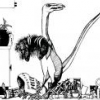
 Subscriber
Subscriber

